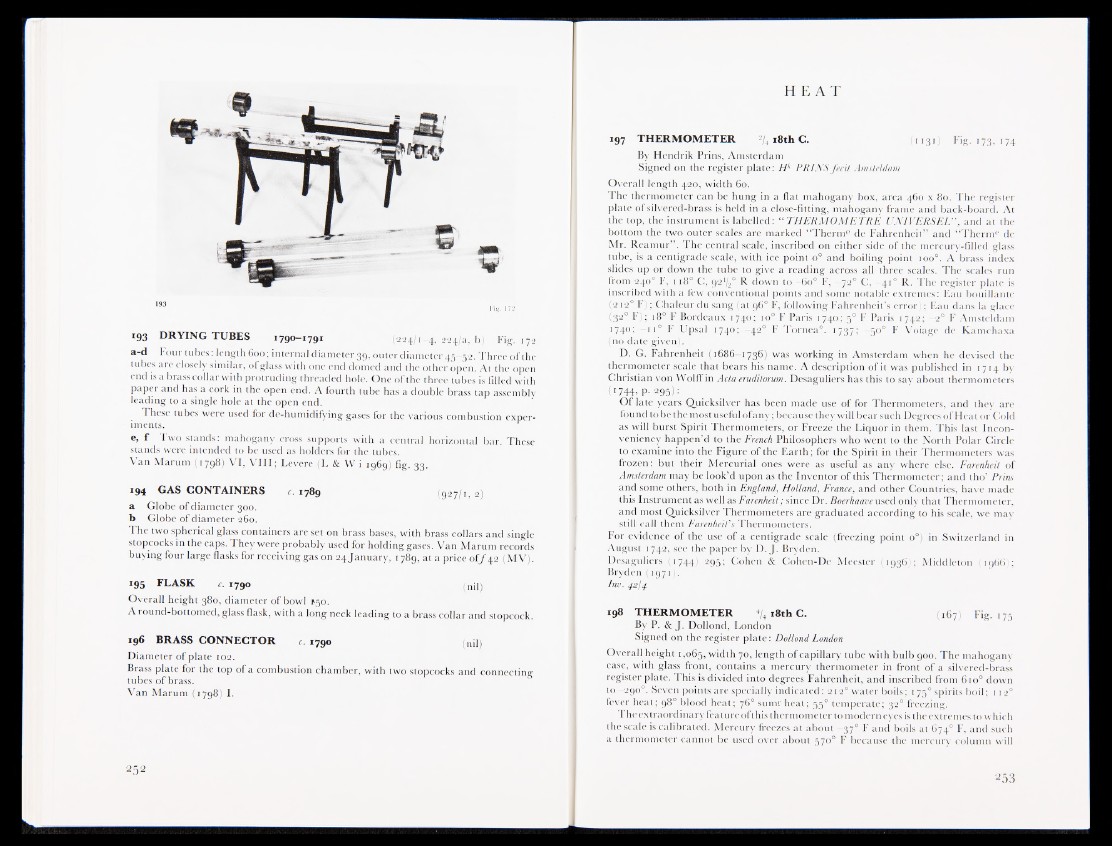
193 DRYING TUBES 1790-1791 (/24/1-4, 224/a, b|i. FiB 172
a-d Four tubes: length 600; internal diameter 39, outer diameter 45-52. Three of the
tubes are closely similar, of glass with one end domed and the other open. At the open
end is a brass collar with protruding threaded hole. One of the three tubes is filled with
paper and has a cork in the open end. A fourth tube has a double brass tap assembly
leading to a single hole at the open end.
These tubes were used for de-humidifying gases for the various combustion experiments.
e, f Two stands: mahogany cross supports with a central horizontal bar. These
stands were intended to be used as holders for the tubes.
Van Marum (1798) VI, VIII; Levere (L & W i 1969) fig. 33,.
194 GAS CONTAINERS c. 1789 (927/3,2)
a Globe of diameter 300.
b Globe of diameter 260.
The two spherical glass containers are set on brass bases, with brass collars and single
stopcocks in the caps. They were probably used for holding gases. Van Marum records
buying four large flasks for receiving gas on 24 January, 1789, at a price o f/42 (MV).
*95 FLASK c , 1790 (nip
Overall height 380, diameter of bowl »50.
A round-bottomed, glass flask, with a long neck leading to a brass collar and stopcock.
196 BRASS CONNECTOR c. 1790 ® nii)H
Diameter of plate 102.
Brass plate for the top of a combustion chamber, with two stopcocks and connecting
tubes of brass.
Van Marum (1798) I.
H E A T
197 THERMOMETER V. 18th C. (1131) Fig. 173, 174
By Hendrik Prins, Amsterdam
Signed on the register plate: Hk PRINS fecit Amsleldam
Overall length 420, width 60.
The thermometer can be hung in a flat mahogany box, area 460 x 80. The register
plate of silvered-brass is held in a close-fitting, mahogany frame and back-board. At
the top, the instrument is labelled: “ THERMOMETRE UN1VERSEL” , and at the
bottom the two outer scales are marked “Therme de Fahrenheit” and “ Therm1' de-
Mr. Reamur” . The central scale, inscribed on either side of the mercury-filled glass
tube, is a centigrade scale, with ice point 0° and boiling point too0. A brass index
slides up or down the tube to give a reading across all three scales. The scales run
from 240° F, 1180 C, 92;/2° R down to 6o° F, — 720 C, —4!* R. The register plate is
inscribed with a few conventional points and some notable extremes: Fau bouillante
H2120 F); Chaleur du sang (at 96° F, following Fahrenheit’s error); Fau dans la glace
IS^ljF) ; 18° F Bordeaux 1740; io° F Paris 1740; 5° F Paris 1742; -2° F Amsteldam
■ 74°i ~i i ° F Upsal 174°> ~42° F Tornea0. 1737; -50° F Voiage de Kamchaxa
(no date given).
D. G. Fahrenheit (1686-1736) was working in Amsterdam when he devised the
thermometer scale that bears his name. A description of it was published in 1714 bv
Christian von Wolffin Acta eruditorum. Desaguliers has this to say about thermometers
^ 744, P- 29^ E
Of late years Quicksilver has been made use of for Thermometers, and they are
found to be the most useful ofany; because they will bear such Degrees of Heat or Cold
as will burst Spirit Thermometers, or Freeze the Liquor in them. This last Incon-
veniency happen’d to the French Philosophers who went to the North Polar Circle
to examine into the Figure of the Earth; for the Spirit in their Thermometers was
frozen: but their Mercurial ones were as useful as any where else. Farenheit of
Amsterdam may be look’d upon as the Inventor of this Thermometer; and tho’ Prins
and some others, both in England, Holland, France, and other Countries, have made
this Instrument as well as Farenheit : since Dr. Boerhaave used only that Thermometer,
and most Quicksilver Thermometers are graduated according to his scale, we may
still call them FarenhejPs Thermometers.
For evidence of the use of a centigrade scale (freezing point 0°) in Switzerland in
August 1742, see the paper bv D. J. Bryden.
Desaguliers (1744) 295; Cohen & Cohen-De Meester (1936); Middleton (1966);
Bryden (i97§|§|/;
Inv. 42 j 4
198 THERMOMETER % 18th C. (167) Fig. 175
By P. & J. Dollond, London
Signed on the register plate: Dollond London
Overall height 1,065, width 70, length of capillary tube with bulb 900. The mahogany
case, with glass front, contains a mercury thermometer in front of a silvered-brass
register plate. This is divided into degrees Fahrenheit, and inscribed from 6xo° down
to -2900. Seven points are specially indicated : 212° water boils; 1750 spirits boil; 1120
fever heat; 98° blood heat; 76“ slim!' heat; 550 temperate; 320 freezing.
The extraordinary feature of this thermometer to modern eyes is the extremes to which
the scale is calibrated. Mercury freezes at about -370 F and boils at 674° F, and such
a thermometer cannot be used over about 570° F because the mercury column will